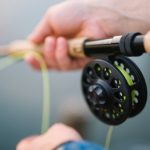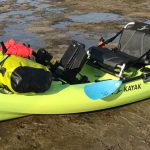In this article, we’ve got all the information you need to decide on the optimal kayak size. Discuss kayak sizes like a pro!
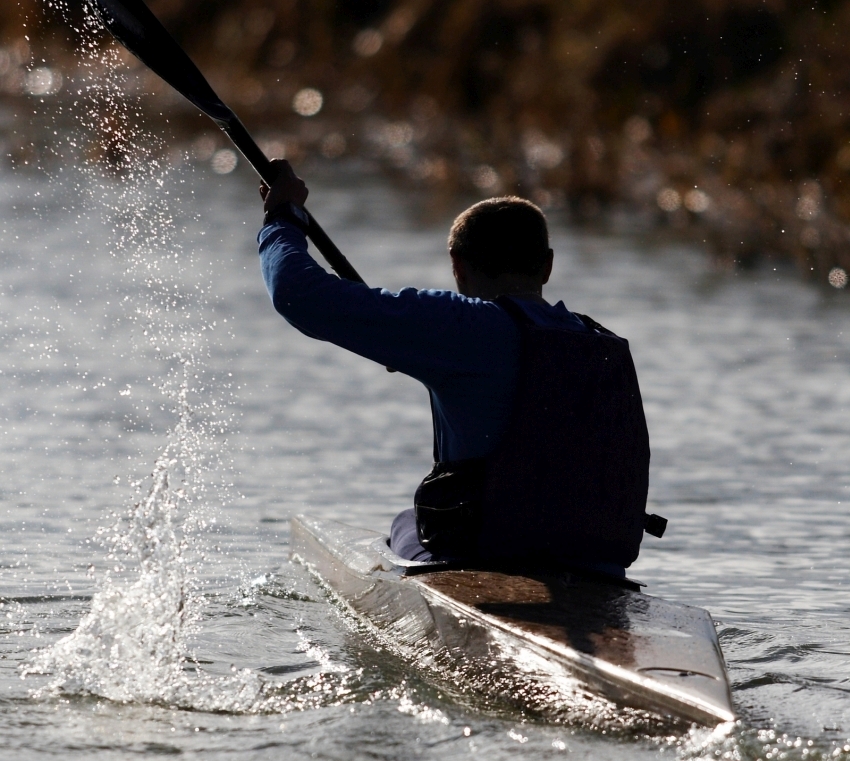
Whether you are a whitewater enthusiast or a beginner looking to purchase your first kayak, your kayak’s stability is a top concern. This guide will tell you what factors contribute to a kayak’s stability, the difference between primary stability and secondary stability, and how to determine which type of stability is important for you. Last, we will tell you what to do to make your own kayak more stable.
So, are kayaks stable? Let’s find out.
What is Stability?
When we talk about kayak stability, we are referring to the kayak’s ability to resist rolling over and capsizing. After all, what good is a kayak if it can’t keep you above water?
So, what determines the stability of a kayak? Do you remember your high school physics class that you thought you would never use? Well, volume and length to width ratio, and center of gravity are all factors in a kayak’s stability.
Center of gravity and center of buoyancy

In order for a kayak to float, the weight of the kayak needs to be equal to the weight of the displaced water. The weight of the weight is measured in a downward line called the center of gravity. The weight of the displaced water is measured in an upward line called the center of buoyancy. As long as the two are in line with each other, the kayak remains stable and upright.
When the kayak shifts, the center of gravity moves with it, so therefore the center of buoyancy needs to move to counteract the change and push the kayak back into an upright position. This is known as a righting torque. However, if the center of gravity tilts too much, then the center of buoyancy will work with it and capsize the boat.
How the center of buoyancy works against the center of gravity also affects the kayak’s stability. When you are riding waves, your center of gravity is constantly changing. If the center of buoyancy doesn’t change as well, you will find yourself making a wet exit.
Primary Stability
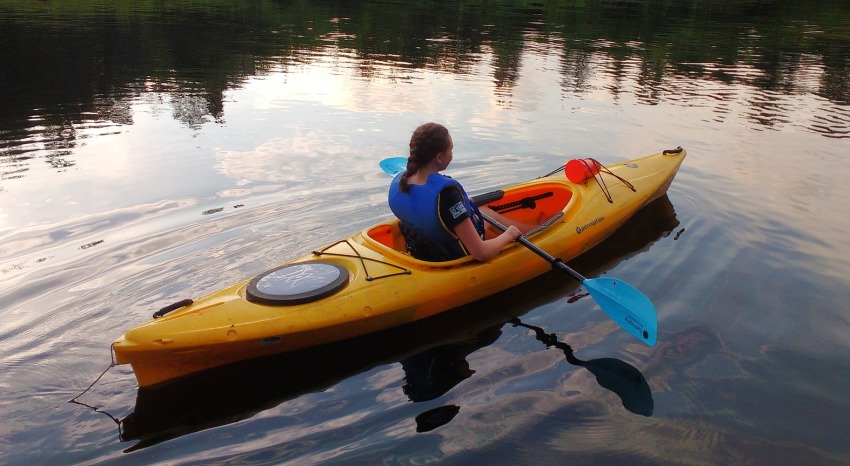
Primary stability is how your kayak reacts when you first get into or on it.
How much does it resist tilting side to side? Does your kayak feel like it’s going to capsize as soon as you try to get into it? This type of stability is known as primary stability and is what many beginners consider when purchasing a kayak. They want to know that the kayak won’t capsize as soon as they try to get in.
Secondary Stability
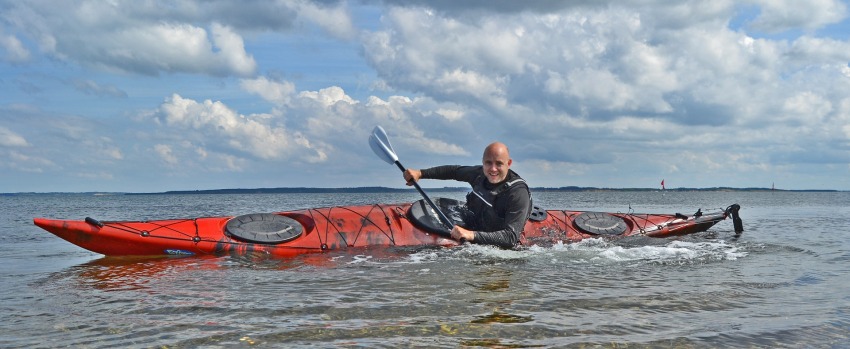
Secondary stability refers to how well your kayak keeps from capsizing when you tilt it (this is also known as “edging” a kayak). Kayaks that have better secondary stability may feel “tippy” when you first get in them but then “grip” once you lean on a side.
Unfortunately, it’s hard to find a kayak that has both great primary stability and secondary stability. You will need to choose one over the other depending on your reason for buying a kayak and the type of water where you will be paddling.
Kayaks with better primary stability are useful for paddling on calm lakes and slow-moving rivers. Also, fishing kayaks have excellent primary stability for casting and even standing.
People looking to do whitewater kayaking, ocean touring, surfing rough waves, or racing should look more at the kayak’s secondary stability.
What Determines a Kayak’s Stability?

So, how does one figure out how stable their kayak will be and whether it has more of primary or secondary stability? Here are some factors you want to consider.
Type of Kayak
Kayaks are designed for a specific use and you have several options when it comes to choosing one. All of them have different stability ratings and have either better primary or secondary stability. Here are just a few:
- Sit-on or sit-in kayak
- A single person or a tandem kayak
- Fishing, recreational, touring, ocean/sea, or whitewater kayak
Length to Width Ratio
This section is where things start to get technical. A kayak’s length, width, and volume all affect a kayak’s stability.
First, let’s discuss displacement, which is the amount of water displaced when a kayak is just sitting in the water. The weight you add to the kayak increases the displacement, which is measured in volumes.
Next up is length. There are two types of length. The first type is length overall (LOA) which is the length of the kayak from bow to stern (front to back). The second type of length is the length of the kayak where the kayak meets the waterline (LWL). This type is also known as its displacement length and is actually more important than length overall because it is the part of the kayak connecting to the water.
The third is the kayak’s width (beam), which refers to its width at its widest point. Like length, there are two types of width – beam overall (BOA) and beam at the waterline (BWL). The BWL is the part of the kayak that interacts with the water and is considered your displacement width.
Are you still with me? Good.
Now we consider the length to width ratio, which we determine by this equation: length at waterline divided by the beam at the waterline, or more simply:
LWL/BWL
A higher length to width ratio means that the kayak is longer and faster. For example, whitewater kayaks will have a length to width ratio of 6:1, while a sprint kayaking for racing has a ratio of at least 11:1 or higher.
So, what do all these numbers have to do with stability? Basically, you can have two kayaks with the same length; however, the kayak with the lower length to width ratio has more of the kayak making contact with the water, thus providing more stability. In contrast, the same length boat with a higher number is making less contact with the water so that it will be faster but less stable.
Hull Type
The hull is the bottom of your boat. There are two types of hulls, planing hull and displacement hulls. Most hulls, however, have at least some characteristics of both types.
Planing Hull
The planing hull is flatter on the bottom and just rides on top of the water. While a kayak with a planing hull has better primary stability, it takes a while to build up speed and they are prone to tipping over when they hit rough waves. This type of hull is popular among whitewater kayaks.
Displacement Hull
The displacement hull has a rounded shape and is designed to cut through (displace) water and move it out of the way. Kayaks with this type of hull feel less stable, however they accelerate faster. They also have an easier time handling waves.
Hull Design

Another thing to consider is the design of the hull. There are four shapes of hull design: pontoon, v-shape, rounded, and flat. Let’s take a look at each one.
V-Shaped Hull
As the name implies, the hull of this kayak is designed like a sharp V. It has a pointed bottom and comes up sharply on the side. A kayak with a V-shape hull can quickly cut through the water and is built more for speed. With less width connecting with the water, it doesn’t have good primary stability and will feel “tippy” to a beginner kayaker. However, they do have excellent secondary stability, and that “tippy” feeling goes away once you get going.
Rounded Hull
While not quite as severe as the V-shaped hull, a rounded hull is still considered better at secondary stability than primary stability. Kayaks with a rounded hull have the appearance of a torpedo and can move at fast speeds.
Flat Hull
Kayaks with flat hulls probably offer the best primary stability. Their flat bottom makes plenty of contact with the surface of the water, so while they don’t move fast, they are a good choice for beginners, anglers, and people who enjoy leisurely paddling.
Pontoon Hull
The kayak with a pontoon hull design offers excellent primary stability. Many fishing kayaks have a pontoon design that allows the person to stand up and cast without the worry of capsizing. While kayaks with pontoon designs won’t move at any great speed, there are some that are almost impossible to tip, even on choppy waters.
Other Factors
So far, we’ve covered hull design, length to width ratio, and the type of kayak that factor into a kayak’s primary and secondary stability. There are still a couple of other things to consider, such as a kayak’s fatness ratio, chine and rocker profile, the center of gravity, and the center of buoyancy. Let’s go ahead and break those down.
Fatness ratio
The fatness ratio doesn’t have anything to do with how stable a kayak is with a heavier person. Instead, it considers the volume of a kayak, which is how much a kayak is designed to carry. It is also referred to as displacement volume. As you may recall from earlier, displacement is how much space a kayak and all its contents takes up that would usually be taken by water. A smaller number means the kayak is longer and lightweight, such as a sprint kayak. A higher number would usually refer to a shorter, heavier kayak and typically includes several whitewater models.
Chine and Rocker Profile
If you are standing directly in front of a kayak, you will see where the hull’s bottom meets the sides. That is the chine, and there are two types – soft and hard. A soft chine has rounded curves, whereas a hard chine has more defined edges and a boxy look. The rocker profile refers to the curvature of the kayak from front to back if you were looking at a side view (also known as “banana shape”).
What Kind of Stability is Best for You?
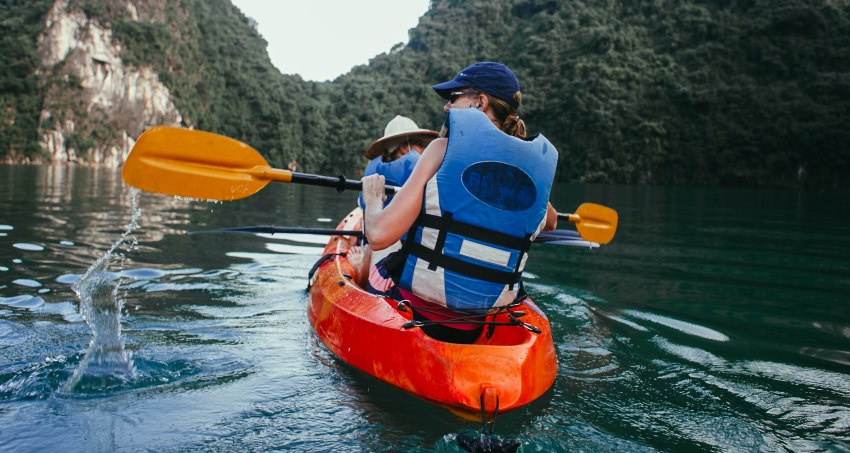
Fortunately, kayak manufacturers design a kayak’s stability based on its specific use. Two things should determine whether you should prioritize a kayak’s primary or secondary stability.
First, how do you intend to use your kayak? Do you live near small lakes and lazy rivers? Do you plan to use your kayak for fishing or paddling around with family or friends? If that sounds like you, then you will want a kayak that offers better primary stability.
On the other hand, if you live near the ocean and plan to surf some waves or go on swift-moving or whitewater rivers, you will want a kayak that prioritizes secondary stability. They will give you the ability to go past the center of equilibrium with the edge almost in the water and still not capsize.
Your comfort level is also a critical factor in deciding on a kayak. You may be nervous getting into a kayak that feels “tippy,” but as your kayaking skills increase, so will your confidence. The kayak becomes an extension of your body as you maneuver it through the waters.
This video does an excellent job of explaining why a “tippy” kayak is the better choice when paddling rougher waters:
How to Improve Your Kayak’s Stability
There are several ways to improve your kayak’s stability, whether it be a kayak you already have or one you are looking to buy.
First, get the right kayak based on your height and weight. If you are a 300 pound, 6’3” male, then you should not be using your child’s kayak rated for 150 pounds. There are plenty of kayaks on the market, and whether you are big or small, there is one that is just the right size for you.
Second, are you planning to purchase a sit-on-top or a sit-in kayak? Typically, a sit-in kayak gives you a lower center of gravity and has better stability than a sit-on-top.
Last, as we mentioned before, how do you intend to use your kayak? Kayak manufacturers produce kayaks for specific uses and stability. Whatever you’re into, there is a kayak out there for you.
If you already have a kayak, there are some things you can try to improve its stability, such as making sure that you distribute your load equally. Having too much in either the front or back will throw off your kayak’s balance in the water.
Another thing you can try is adding stabilizers, or outriggers, to your kayak. These outriggers attach to the side of your kayak to provide added stability while you’re in the water.
How to Improve Your Own Stability

Working on your own physical fitness can also help you feel more comfortable in your kayak. There are several muscle groups you can target to improve your balance and stability.
As you become a more experienced kayaker, you will come to realize that your kayak is almost an extension of your own body. You use your hips and legs a lot to maneuver your kayak and help keep it upright, so you will want to make sure to strengthen your lower body. Deadlifts and side leg raises will help target these muscles.
Core strength is essential for keeping your torso upright. A strong lower back and abs give support to your spine along with safe and effective hip movements. Planks, Russian twists, and superman exercises help strengthen the muscles in your torso.
Yoga poses that focus on balance also help you maintain stability in a kayak. Most people have better balance on one side compared to the other. Moves such as the tree pose, eagle pose, and dancer pose can help you improve balance and equilibrium on both sides of the body.
FAQ
A wider kayak will offer more primary stability. It provides more surface-to-water contact and distributes the kayak’s volume across a greater area. However, you will give up a lot in terms of speed and maneuverability.
Inflatable kayaks are very stable. They typically are wider and provide better buoyancy than hard shell kayaks. Inflatable kayaks are difficult to tip over, and they are also incredibly durable.
Tandem kayaks are usually more stable than single kayaks. However, they also have their limitations. Many couples new to kayaking will usually purchase a double kayak, which is great if both parties enjoy kayaking equally. But, it makes it hard if one person wants to go out kayaking and the other wants to stay home. Furthermore, having two single kayaks allows a backup in the event one capsizes.
Some Terms to Know
Length Overall – the length of your kayak from bow to stern
Displacement Length – the length of your kayak that is making contact with the waterline.
Fatness Ratio – the weight of a kayak and its contents divided by displacement length and then cubed.
Beam Overall – the width of your kayak at its widest point.
Beam at the Waterline – the width of the kayak that is making contact with the waterline.
Volume – how much a kayak is designed to carry.
Bottom Line
Several factors determine the stability of a kayak, such as length, width, volume, and hull design. Kayaks will have either better primary stability or secondary stability. Your intended purpose determines the type of kayak you should purchase and the type of stability it will have.
If you plan to use your kayak on calm waters or slow-moving rivers, then a kayak with better primary stability is what you are looking for.
However, if you are looking to use your kayak in the ocean or sea, whitewater rivers, or race, you should prioritize secondary stability.
Before you purchase a kayak, you should try a few different ones out first. Check with your friends and some kayak rental places so you can try a wide variety. Take this article with you for reference when you are looking at kayaks so you can see how length, width, and hull design make a difference in both primary and secondary stability.


